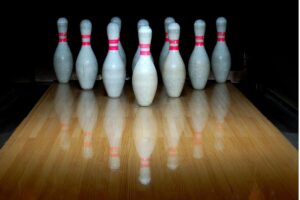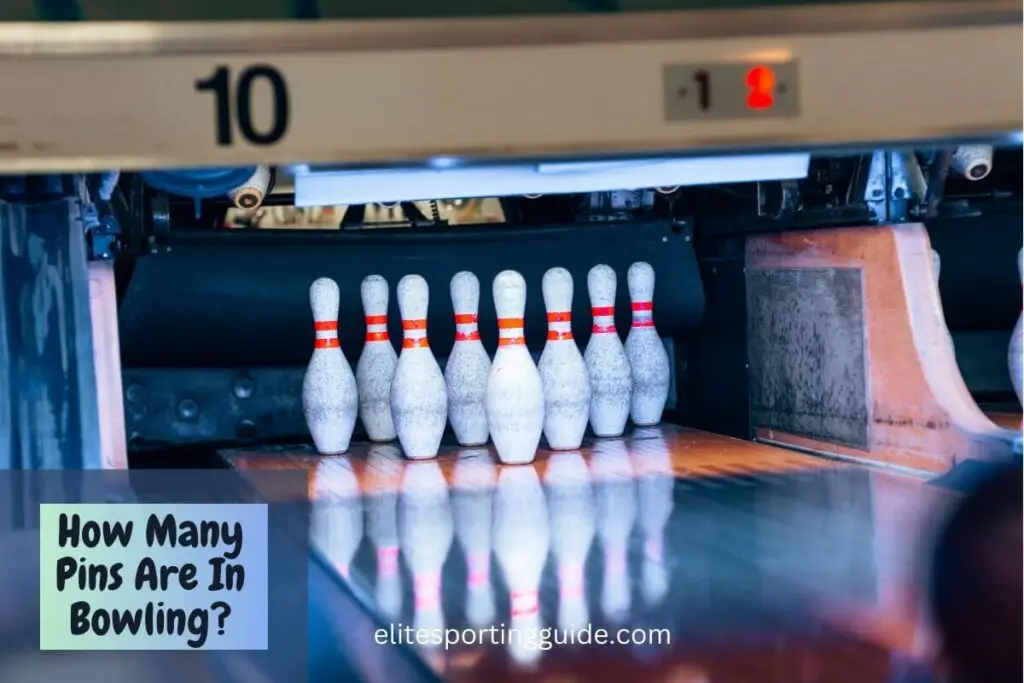Step onto the polished wooden lanes, grasp the weighty orb in your hand, and prepare to enter the world of bowling.
As you navigate the mesmerizing sounds and sights of the alley, one question lingers in the air: how many pins are in bowling?
In this fascinating article, we unravel the mystery behind the arrangement and count of those slender yet sturdy pins that stand tall, beckoning players to take aim and strive for perfection.
Join us on this illuminating journey as we look into the captivating history, intricacies, and surprising facts surrounding the precise number of pins that make bowling a true test of skill and precision.
How Many Pins Are In Bowling?
In traditional ten-pin bowling, there are a total of ten pins arranged in a triangular formation at the end of the lane. When knocked down by a rolling ball, they offer an exciting challenge for bowlers aiming to achieve a strike or spare.
The Origins and Evolution of Bowling Pin Counts
Bowling, one of the oldest known sports, has a rich history that spans centuries. The origins of bowling pin counts can be traced back to ancient Egypt, where primitive forms of the game were played with stone balls and pins made of various materials such as wood or pottery.
As the game migrated to different regions, the number of pins used varied widely.
In medieval Europe, for instance, a popular variation known as “nine-pin bowling” emerged, featuring, as the name suggests, nine pins that were arranged in a diamond shape.
However, the evolution of bowling pin counts took a significant turn in the United States during the 19th century.
Amid concerns about gambling and associated scandals, the American Bowling Congress (ABC) was established in 1895.
As part of their efforts to standardize the game, the ABC introduced the ten-pin configuration that is widely recognized today.
The triangular arrangement of ten pins became the norm, offering a balanced and challenging setup that required skill, accuracy, and strategy to knock down all the pins with a single roll.
Since then, the traditional ten-pin bowling format has become the most prevalent and widely practiced worldwide.
Its popularity has endured through the decades, captivating both casual bowlers and professional competitors.
The evolution of bowling pin counts reflects the game’s continual quest for balance, fairness, and exciting gameplay.
Whether it’s the mesmerizing sound of a strike or the anticipation of a spare, the arrangement of ten pins remains an integral part of the sport’s charm, preserving the legacy and heritage of bowling for generations to come.
Understanding the Traditional Ten-Pin Configuration

The traditional ten-pin configuration in bowling is a testament to precision and challenge.
Ten pins are arranged in a triangular formation at the end of the lane, with the headpin positioned at the apex
The remaining nine pins are then placed behind the headpin, forming two rows of four and five pins respectively. This arrangement creates a visually striking setup that demands accuracy and skill from bowlers.
Each pin in the traditional ten-pin configuration has a specific purpose. The headpin, positioned directly in front, serves as the primary target for bowlers aiming for a strike.
Knocking down the headpin with enough force can cause a chain reaction, resulting in multiple pins falling and achieving the coveted strike.
The remaining pins act as obstacles and offer different scoring opportunities. The pins in the second row, known as the “corner pins,” require careful targeting and precision to hit, while the back row pins provide a challenge for bowlers attempting to convert spares.
Understanding the traditional ten-pin configuration is crucial for bowlers aiming to master the game.
It involves analyzing the angles, considering ball speed, and adjusting one’s approach to maximize the chances of knocking down as many pins as possible.
The configuration’s triangular shape also adds an element of strategy, as bowlers must decide which pins to target first to create the optimal pinfall pattern for maximum scoring potential.
With its intricate design and inherent complexities, the traditional ten-pin configuration continues to captivate bowlers of all skill levels, offering endless opportunities for excitement, competition, and personal achievement on the lanes.
Exploring Variations: Nine-Pin, Five-Pin, and Candlepin Bowling
Bowling, a sport that transcends borders and cultures, has seen various regional adaptations that add their own unique flair.
Three notable variations are nine-pin, five-pin, and candlepin bowling.
Nine-pin bowling, with its origins in Europe, features, as the name implies, nine pins arranged in a diamond shape.
This variation gained popularity in countries like Germany and Austria, where it continues to be a beloved pastime. The smaller pin count presents its own set of challenges, as bowlers must aim precisely to knock down all nine pins and avoid any penalties.
In Canada, five-pin bowling takes center stage. This variation deviates from the traditional ten-pin format by utilizing smaller pins and a smaller ball.
Five pins are arranged in a V-shaped formation at the end of the lane, requiring bowlers to adapt their techniques for the narrower target.
The absence of the back row of pins introduces a strategic element, as knocking down all five pins with a single roll results in a “strike,” but leaving pins standing can still lead to points with careful pin placements.
Another distinctive variation is candlepin bowling, primarily played in the New England region of the United States and in Eastern Canada.
Candlepin bowling features tall, slender pins that resemble candles, hence the name.
In this variant, ten pins are arranged in a triangular formation like the traditional ten-pin game, but the pins are thinner and lighter, making them more challenging to knock down.
Fallen pins are not cleared between rolls, which adds a strategic element as the standing pins can affect subsequent shots.
These variations showcase the adaptability and creativity within the world of bowling. Each variation offers its own set of rules, techniques, and challenges, providing enthusiasts with diverse experiences and opportunities for camaraderie.
Whether it’s the precise aim required in nine-pin bowling, the skillful finesse demanded in five-pin bowling, or the delicate precision of candlepin bowling, these variations add depth and excitement to the sport, highlighting the endless possibilities and enjoyment that bowling has to offer.
The Importance of Pin Placement and Alignment
Pin placement and alignment play a crucial role in the game of bowling, influencing the difficulty level and strategic choices for bowlers.
The meticulous arrangement of pins can create unique challenges and scoring opportunities.
By strategically positioning pins, bowling alley operators aim to strike a balance between offering an engaging game and ensuring a fair playing field for all participants.
Pin alignment affects the overall dynamics of the game. A well-aligned set of pins presents bowlers with a clear target, enabling them to focus their aim and apply the appropriate technique.
On the other hand, misaligned pins can introduce unpredictability, making it harder for bowlers to consistently achieve desired results.
Pin alignment also influences pin carry, which refers to the ability of a pin to knock down other pins upon impact. Proper alignment maximizes pin carry potential, enhancing the chances of achieving strikes and higher scores.
For professional bowlers, understanding pin placement patterns is essential for success. Patterns such as the “house shot” or the “sport shot” dictate the positioning of the pins on the lane.
These patterns can vary in difficulty, requiring bowlers to adapt their strategies and shot selections accordingly.
Pin placement can influence the ideal trajectory and entry angle for a successful shot, forcing bowlers to make calculated adjustments to navigate the unique challenges presented by each pin configuration.
In summary, pin placement and alignment are vital aspects of the bowling experience.
They contribute to the game’s excitement, challenge players to adapt their strategies, and test their skills and precision.
The careful consideration given to pin positioning ensures a dynamic and engaging sport that keeps bowlers coming back for more, driven by the quest for the perfect strike.
Related post: How Bowling Pins Are Set Up
The Role of Pins in Scoring and Gameplay Strategies
Pins in bowling serve as the ultimate measure of success and directly impact a player’s scoring. Knocking down pins is the primary objective, with each pin that falls contributing to the final score.
Scoring is determined by the number of pins knocked down in each frame, with bonuses awarded for achieving strikes (knocking down all pins with the first ball) or spares (knocking down all remaining pins with the second ball).
The arrangement of pins influences the strategic decisions of players, who must carefully calculate their shots to maximize pinfall and optimize their score.
The role of pins in gameplay strategies extends beyond mere point accumulation. Skilled bowlers use pin positions as valuable indicators of lane conditions and adjust their approaches accordingly.
Observing how pins react to different shots helps bowlers gauge the lane’s oil patterns and adjust their targeting, ball speed, and angle of entry.
Understanding the pin action can guide bowlers in making educated choices about ball selection, where to aim, and how to adapt their game plan to achieve consistent success.
Ultimately, pins in bowling serve as both targets to knock down for scoring purposes and valuable sources of information for strategic decision-making.
They are the central element around which the game revolves, demanding precision, adaptability, and a deep understanding of the intricate interplay between bowler, ball, and pin.
The role of pins in scoring and gameplay strategies adds depth and complexity to the sport, making each frame a unique challenge and a thrilling pursuit of bowling mastery.
Fun Facts and Trivia about Bowling Pins
1. Did you know that traditional bowling pins are typically made of a combination of wood and synthetic materials?
The body of the pin is made of hard maple wood, while the neck, or “pinhead,” is usually constructed from a synthetic material like plastic.
This hybrid design helps provide durability and consistency in pin performance.
2. Have you ever wondered why bowling pins are shaped the way they are? The iconic shape of a bowling pin, known as “skittle” in some regions, is believed to have originated from the sport’s early days in Europe.
The design evolved from the shape of a bottle or jug, with a wide base for stability and a tapered neck to make it easier for bowlers to knock them down.
3. Have you ever noticed the distinctive numbering system on bowling pins? Each pin is marked with a number, usually between 1 and 10, which identifies its position in the arrangement.
This numbering system allows bowlers to communicate pin setups and strategies with one another. Additionally, it helps pin technicians quickly identify and replace specific pins if they get damaged during play.
4. Candlepin bowling, primarily played in the New England region of the United States, offers a unique twist on traditional bowling pins. Instead of the tall and slender pins seen in ten-pin bowling, candlepin bowling features shorter, cylindrical pins that resemble candles.
Their compact size and lightweight construction make them notoriously difficult to knock down, adding an extra level of challenge and excitement to the game.
5. Bowling pins have a fascinating lifespan! After years of service on the lanes, when they become worn or damaged, they are retired from active play.
Some retired pins find new purposes as decorations, trophies, or even recycled materials for various crafts. It’s not uncommon to come across creative uses for old bowling pins, such as bookends, lamp bases, or garden decorations, as they continue to bring joy even in their retired state.
These fun facts and trivia about bowling pins showcase the intricate details and intriguing aspects of the sport.
From their unique construction to their role in gameplay, bowling pins add charm and character to the game, making it an enjoyable pastime for people of all ages.
Modern Technological Advancements in Bowling Pin Design

Modern technological advancements have made their way into the world of bowling, including innovative improvements in bowling pin design. One notable development is the introduction of synthetic bowling pins.
While traditional pins were primarily made of wood, synthetic pins are crafted from advanced composite materials such as high-density polyethylene.
This new material offers enhanced durability, consistency, and longevity compared to their wooden counterparts. Synthetic pins also provide a more predictable pin action, allowing bowlers to better understand and adapt to their behavior on the lanes.
Another significant advancement is the implementation of pinsetter machines.
These automated systems efficiently arrange and set up the pins after each roll, eliminating the need for manual pin resetting. Pinsetter machines have revolutionized the game by improving the speed and efficiency of gameplay, allowing for a smoother and uninterrupted bowling experience.
With pinsetter technology, bowlers can focus more on their technique and strategy, without the interruptions and delays associated with manual pin resetting.
Another exciting advancement is the incorporation of RFID (Radio Frequency Identification) technology into bowling pins.
RFID tags embedded within the pins allow for accurate tracking and identification of individual pins.
This technology enables automatic scoring systems to precisely detect and record pinfalls, reducing human error and ensuring more accurate scorekeeping.
Additionally, RFID-enabled pins offer the potential for interactive features and augmented reality experiences, paving the way for new and immersive gameplay possibilities.
Also, one notable development is the introduction of LED-equipped pins. These pins feature built-in LED lights that illuminate upon impact, creating a visually stunning display.
Not only do LED pins enhance the overall aesthetic appeal of the game, but they also provide a unique sensory experience for bowlers and spectators alike, adding an extra layer of excitement and entertainment to the bowling alley.
These modern technological advancements in bowling pin design not only enhance the visual appeal of the game but also contribute to improved gameplay, accuracy, and overall engagement.
As technology continues to advance, we can anticipate further innovations that will push the boundaries of bowling pin design, elevating the sport to new levels of excitement and enjoyment for bowlers and spectators alike.
The Art of Pin Setup and Maintenance in Bowling Alleys
The art of pin setup and maintenance in bowling alleys is a meticulous process that ensures optimal playing conditions and fair gameplay.
Bowling alley technicians meticulously arrange the pins in precise positions, adhering to specific pin placement patterns. These patterns vary depending on the game format and can affect the level of difficulty and strategy required by bowlers.
Additionally, regular maintenance is necessary to keep the pins in optimal condition. Technicians carefully inspect and clean the pins, addressing any signs of wear or damage.
They also rotate and replace pins as needed to maintain consistency and prevent excessive wear on specific pins. The art of pin setup and maintenance is essential in creating a consistent and enjoyable bowling experience for all participants.
The Timeless Allure of Bowling Pins
Bowling pins hold a timeless allure that captivates people of all ages. Their simple yet iconic design, with the distinct shape and numbering, evokes a sense of nostalgia and familiarity.
The anticipation of seeing pins arranged at the end of the lane and the exhilarating sound of them crashing down upon impact create a unique thrill.
Bowling pins symbolize competition, camaraderie, and the pursuit of achievement.
Whether you’re a casual bowler enjoying a fun night out or a professional athlete striving for perfection, the sight of bowling pins invites a sense of excitement and challenge, making them an enduring symbol of the beloved sport of bowling.
Post you may be interested in: What Is Duckpin Bowling?



